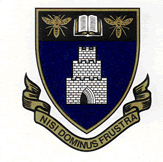
St John's Wood is a district in the City of Westminster, London, England, about 2.5 miles (4 km) northwest of Charing Cross. Historically the northern part of the ancient parish and Metropolitan Borough of Marylebone, it extends from Regent's Park and Primrose Hill in the east to Edgware Road in the west, with the Swiss Cottage area of Hampstead to the north and Lisson Grove to the south.

The Inner London Education Authority (ILEA) was the local education authority for the City of London and the 12 Inner London boroughs from 1965 until its abolition in 1990. From 1965 to 1986 it was an ad hoc committee of the Greater London Council; on 1 April 1986 it was reconstituted as a directly elected body corporate.

The Metropolitan Borough of St Marylebone was a metropolitan borough of the County of London from 1900 to 1965. It was based directly on the previously existing civil parish of St Marylebone, Middlesex, which was incorporated into the Metropolitan Board of Works area in 1855, retaining a parish vestry, and then became part of the County of London in 1889.

The Royal Grammar School (RGS), Newcastle upon Tyne, is a selective British private day school for pupils aged between 7 and 18 years. Founded in 1525 by Thomas Horsley, the Mayor of Newcastle upon Tyne, it received royal foundation by Queen Elizabeth I and is the city's oldest institution of learning. It is one of seven schools in the United Kingdom to bear the name "Royal Grammar School", of which two others are part of the independent sector.

Westminster City Council is the local authority for the City of Westminster in Greater London, England. It is a London borough council, one of 32 in London. The council has been under Labour majority control since 2022. Full council meetings are generally held at Westminster Council House, also known as Marylebone Town Hall, and the council has its main offices at Westminster City Hall on Victoria Street.

Launceston Church Grammar School is an Anglican co-educational private school in Launceston, Tasmania, Australia for Early Learning through to Grade 12.

Cowbridge Grammar School was one of the best-known schools in Wales until its closure in 1974. It was replaced by Cowbridge Comprehensive School.

Borden Grammar School is a grammar school with academy status in Sittingbourne, Kent, England, which educates boys aged 11–18. A small number of girls have also been admitted to the Sixth Form. The school holds specialist status in sports.
Lisson Grove is a street and district in the City of Westminster, West London. The West End neighbourhood contains a few important cultural landmarks, including Lisson Gallery, Alfies Antique Market, Red Bus Recording Studios, the former Christ Church, now the Greenhouse Centre, and the Seashell of Lisson Grove.
Clapham College was a Roman Catholic secondary school for boys in South London.

Leeds Grammar School was an independent school founded 1552 in Leeds, West Yorkshire, England. Originally a male-only school, in August 2005 it merged with Leeds Girls' High School to form The Grammar School at Leeds. The two schools physically united in September 2008.
Battersea Grammar School was a Voluntary-Controlled Secondary Grammar School in South London. It was established in Battersea in 1875 by the Sir Walter St John Trust and moved to larger premises in Streatham in 1936.

Fairfield Grammar School was a secondary school in Bristol, England, founded in 1898 as Fairfield Secondary and Higher Grade School. It became a grammar school in 1945 and closed in 2000, to be replaced by a new comprehensive, Fairfield High School, at first on the same site, but now located in Stottbury Road, Bristol. BHES, is now based in half of the old school, the other half is now Fairlawn Primary School.

Abercorn School is an independent private school in central London for pupils ages 2–16 years. In September 2021, Abercorn School announced that the school will begin taking 13–14-year-olds from September 2022 as part of a wider expansion plan to welcome 11–18-year-olds over the coming years.

Sir Robert Leicester Harmsworth, 1st Baronet was a British businessman and Liberal politician.

King Solomon Academy is a non-selective, non-denominational, mixed all-through school within the national academy programme, located in Lisson Grove, in the City of Westminster. It occupies the site of the former Rutherford School.

Marylebone is an area in London, England and is located in the City of Westminster. It is in Central London and part of the West End. Oxford Street forms its southern boundary.
Wyggeston Grammar School for Boys was a grammar school in Leicester, England, in existence from 1876 to 1976.

Lincoln Grammar School or Lincoln Free School was formed as the result of the amalgamation of the Lincoln City Free School and the Lincoln Chapter Grammar School. The amalgamation occurred in January 1584, but the two schools may have been effectively working as single school from 1560. In 1574 Lincoln City Corporation had reached an agreement with Robert Monson who was donating the Greyfriars for use as a Grammar School. This was to replace an older City Free school, which had been in scholegate. The exact location of this Free school is uncertain, but scholegate probably refers to Danesgate, but other evidence suggests that the earlier school was close to St Rumbold's church.
Lisson Green is described as a hamlet in the Domesday book in 1086, the edges of the settlement defined by the two current Edgware Road stations facing onto Edgware Road or Watling Street as it was previously known, one of the main Roman thoroughfares in and out of London. Occasionally referred to as Lissom Grove, originally Lisson Grove was part of the medieval manor of Lilestone which stretched as far as Hampstead. Lisson Green as a manor broke away c. 1236 with its own manor house. Paddington Green formed part of the original Lilestone estate.

















